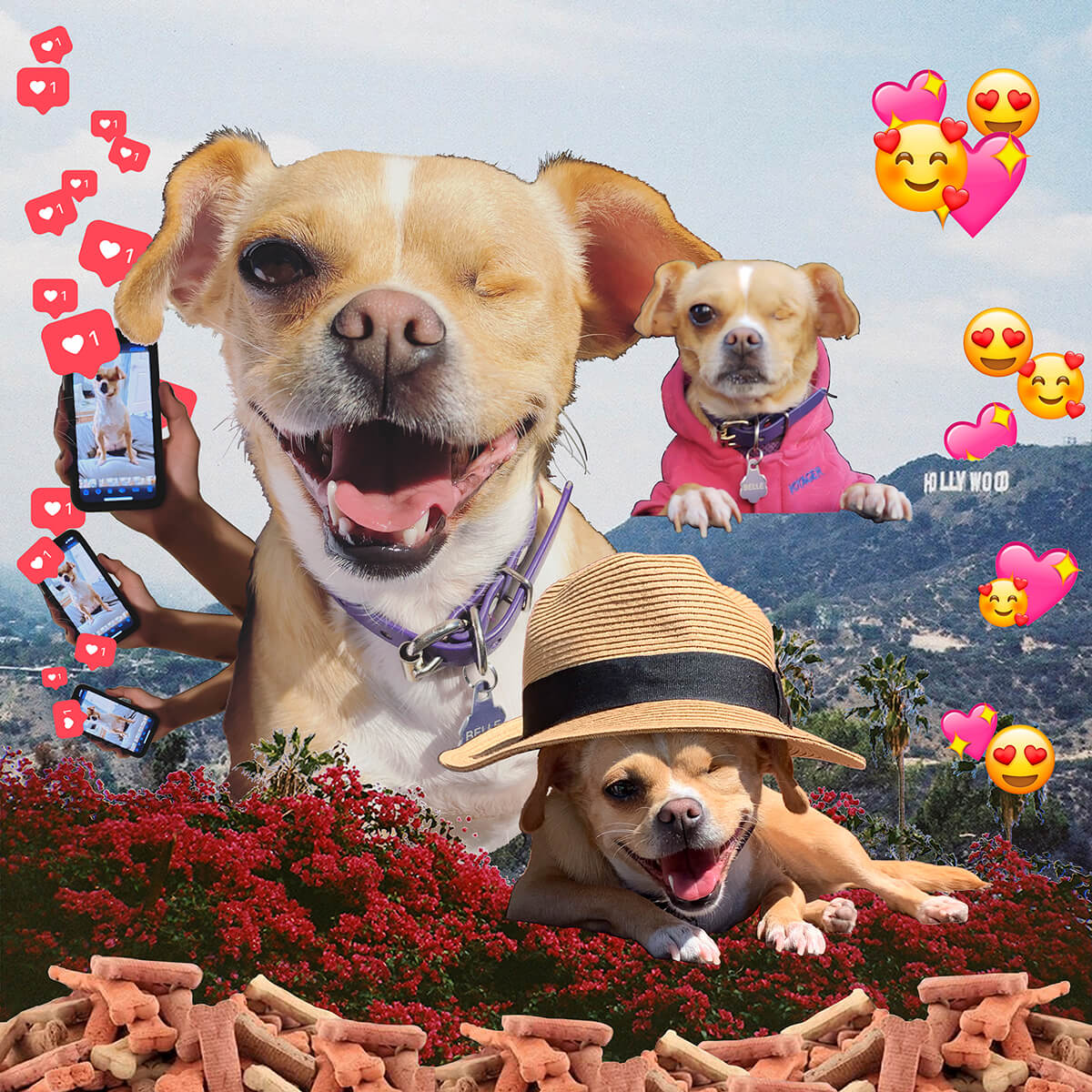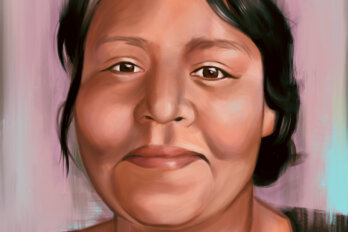Listen to an audio version of this story
For more audio from The Walrus, subscribe to AMI-audio podcasts on iTunes.
When we spotted the one-year-old blonde mutt, on page two of a Kijiji search for dog adoptions, we had no plans to transform her into an internet celebrity. My partner, Arielle, and I had been searching for the next member of our family, and we found the fourteen-pound, one-eyed dachshund mix after scrolling far past the catchy ads for fresh litters of puppies. The Toronto-area rescue that housed her told us we were the first to express interest. We adopted her within the week.
Belle, as we named her, was even cuter in person: her ears flopped in the wind, her face was stuck in an adorable perma-wink, and elevators confused her. Soon, every quirky move she made had us posting pictures of her on our Instagram accounts. Surely, we thought, our friends and family would love her just as much as we did. When it felt like our accounts were flooded with Belle photos, we created her own account, @1eyedbelle, a dedicated space for those interested in our pup’s day-to-day life.
I’d come across many pets in my feed—some with modest followings, others more famous than certain world leaders and bestselling artists. Doug the Pug, a Nashville-based dog, for example, has more Instagram followers than Justin Trudeau and almost as many as Céline Dion. Videos of Maru, Japan’s YouTube-famous cat, have been collectively viewed more than 450 million times, and Pumpkin the Raccoon, who was rescued by a family in the Bahamas after breaking her leg, even got a book deal.
At first, Arielle and I found the concept of pet promotion silly. Why would anyone place that much importance on our mutt? Yet, the more we saw accounts with small followings, the B- and C-list celebrities of the animal kingdom, secure brand deals for paraben-free dog shampoo, omega-3-enriched kibble, and plant-based wipes for puppy paws, the more convinced we became. Belle could do better, we thought. She’s cuter, has more attitude, more pizzazz. I envisioned telling Belle’s Cinderella story: a rescue puppy’s rise to internet icon. The move couldn’t hurt our wallets either.
Pet influencing is booming. A 2018 Forbes article pegs the average endorsement deal for some of the most famous “petfluencers” at more than $2,000 per post; some, like Doug the Pug, are estimated to earn hundreds of thousands a year. There are even industry events, including PetCon—dubbed “the Coachella for Pets” in the New York Post. It’s not hard to see why: people love animals, so they’ve been used in all kinds of advertising for the past century, illustrating everything from the importance of family bonds after the Second World War to the humour of the 1980s and ’90s (think: Taco Bell’s anthropomorphic chihuahua or the Aflac insurance duck). And numerous scientific studies over the decades have proven that animals make us feel better—emotionally, physically, and mentally.
At the very least, we thought, an Instagram-famous dog might earn us some fun freebies: endless doggy sweaters, treats, toys, even poop bags. But my daydream went further. I pictured us packing up our belongings and heading to southern California, where every day is a beach day. We’d live in excess. Belle would have her own room in our oceanside home, where we’d set up elegant photo shoots for sponsored Instagram posts. When we weren’t managing Belle’s career, Arielle and I would spend our days working on passion projects.
As two millennials living in an overpriced Toronto apartment, often working until burnout, we might find the time to enjoy life in a way we never could before. It’d be like winning the lottery. Our scrappy little pup would become our breadwinner.
The first hint that my get-Belle-famous-fast scheme would be harder to pull off than I thought came last summer. I caught her in an unprecedented position: sitting still. She’d tired herself out zipping around my parents’ north Toronto backyard and had plopped down poolside, jaw agape in a crooked canine smile. No better photo opportunity had presented itself in the past two weeks; she was practically smizing.
I tried to be nimble, iPhone in hand, while my toes burned on the concrete deck. In portrait mode, I rapidly tapped the capture button on my screen, cooing at Belle to “look here, sweetie!” She up and ran away, off to grab her coveted Lamb Chop toy. I shot eight photos, most of them blurry. The candid is not Belle’s forte, I quickly learned.
Cute dogs exist in abundance on the internet. To be an influential animal is something else. In the photos I take, Belle doesn’t look natural all dressed up. She also doesn’t hold a pose for long.
Listen to an audio version of this story
For more audio from The Walrus, subscribe to AMI-audio podcasts on iTunes.
In the end, none of the poolside photos made the cut. Instead, I hastily posted a picture of her on a lounge chair, a wide-brimmed fedora atop her head. The photo is an outtake—I caught it while snapping shots of Arielle. In it, Belle is still smiling, her one eye glistening in the sunlight. I cobbled together a list of the most popular dog hashtags and pressed post, butterflies of hope dancing in my stomach. It elicited a grand total of twenty-one likes—a quarter of the number my last selfie received on my own account.
I realized I might need some help. I googled “how to make my dog Instagram famous,” and hundreds of guides popped up. One told me to find what makes Belle unique; another said I needed to harness the power of hashtags. The tips felt generic.
When I spoke with several people behind some of Canada’s most influential dogs, agents and managers for pet influencers, and even researchers on canine-influencer culture, I began to understand. Whether they’re couch potatoes partnering with your favourite snack-food company or high-falutin divas posing beside expensive cars and decked out in the latest couture, pet celebrities have one thing in common: they are symbols of inspiration. Even if Belle was a dog, she needed to portray a life that could be. To be famous, she’d have to convince others she was already living the carefree millennial dream.
Of the dog influencer owners I spoke with, many say fame came organically. “I’m a photographer, so I knew I was going to take a lot of photos of my dog and annoy my family and friends with them,” Christie Vuong tells me. She created a dedicated account for her dog, and Helmut the Pug is now a Toronto celebrity with more than 33,000 followers. His first viral success was a fifteen-second parody of Drake’s “Hotline Bling” video. (In a BuzzFeed poll, 90 percent of respondents concluded that Helmut’s dance moves and puffer jacket were better than Drizzy’s.) It was a cute joke, but not one she thought would blow up. Iggy Joey, an Italian greyhound with more than 80,000 followers, also found fame accidentally. Owner Lyndal Moody shot a photo of the dog sunbathing in the window of a Toronto shop where she worked, a string of pearls around Iggy’s neck. Eventually, the photo got noticed. Iggy became known for her elegance, an Audrey Hepburn type; since then, she’s done brand deals with Zara, Dyson, and even Mercedes Benz.
Jane Peh, who runs a pet social media marketing company, The Woof Agency, says pets are a safer bet than human influencers because they’re less likely to get involved in controversial situations. A dog, for instance, can’t choose to attend a crowded party in the middle of the COVID-19 pandemic, as did several teen influencers last summer.
More people in their twenties and thirties own pets and treat them like their children, pampering them to excess.
Accounts like Helmut’s and Iggy’s are also notable because they represent a generational trend: more and more people in their twenties and thirties own pets and treat them like their children, Peh says, pampering them to excess. In fact, millennials love dogs so much that we’ve created an internet language around them—calling them doggos, puppers, fluffers, or floofs. We flock to Facebook groups to share photos of good boys spotted on the street and offer cuteness ratings for furry friends on Twitter. (Almost every pup rates an easy thirteen or fourteen out of ten.) These wholesome groups can be a salve during stressful times. (Dog-spotting groups could also be considered some of the only apolitical forums left on the internet.) Other theories suggest that being a dog parent is a more achievable dream for a generation stuck between an expensive housing market and unstable jobs. A 2017 study by one business-solutions agency found that nearly half of millennials surveyed see their pet as practice for a child; for those who don’t want children, dogs offer companionship with a much smaller price tag.
But, even with tens of thousands of followers, neither Vuong nor Moody are living that blue-sky LA-influencer life I’d dreamt of, and neither has quit their day job. At times, Moody tells me, she’s made a living off of Iggy’s account, but it was temporary, between jobs. Vuong, meanwhile, sees Helmut’s account solely as a creative side project. That’s the reality for most influencers: only those at the top can reap the greatest benefits. Vuong’s and Moody’s dogs may have significant followings, but it’s not the numbers that keep them posting—it’s the passion and devotion they have for their craft. It’s perhaps what I’m missing when I post about Belle.
One researcher has found that reception to these accounts is fuelled by more than just the pet’s character. In 2019, Menghan Zhang and two of her graduate-school classmates in an ethnography course at Carnegie Mellon University set out to better understand how Instagram operates as a platform for pet influencers. They headed to see some therapy dogs on campus, met a husky named Milo, and created an Instagram account for him, amassing followers and interacting with other influencers on the platform for three weeks. In their research, they found that the brand built by influencers is a kind of aggregate. “At first, we thought the influencer might be the human behind the pet,” Zhang tells me. “But the human is hiding behind the pet. Instead, they are creating a brand that projects both their identities.”
“So it’s not about the person or the pet,” Zhang concludes. “It’s about both of them, combined.”
Scrolling through Belle’s Instagram account after hanging up with Zhang, I became increasingly aware that @1eyedbelle had become a composite sketch of me and my dog, as though we were a single entity. She, posed in a pink athleisure sweater; I, behind the camera in my own Adidas track pants. She, hanging out in the home office with a scowl; I, spending ten hours every weekday in front of a computer screen, resentful. The frisky, goofy Belle I describe to my friends and family is not in these photos. Just like everyone else on the internet, the Belle I sell on Instagram is not the real Belle.
By the end of last summer, Belle had slightly more than 100 followers, but I’d come to terms with my failings. I had started to procrastinate on my project—it felt too much like work. The experiment was a bust.
It wasn’t Belle’s fault. She isn’t the one inadequate at influencer culture—I am. Without a charismatic, witty human behind the account, there’s no hope. And charismatic, witty influencer, I now know, I am not. My own Instagram account is a boring space for anyone who doesn’t already know me, a collection of memories no one but my loved ones would ever care about. Like owner, like dog; it just took an attempt to break the mould for me to see it.
It’s clear that my California-influencer pipe dream will never come to fruition. This failure is mine. But I’m surprised by how disappointing it feels. Peeking behind the curtain, it’s clear how labour intensive it is to keep an influencer account relevant and thriving—there’s a need for constant creativity, an under-standing of analytics and user data, and a desire to be online all the time. It’s a fun job, but it isn’t easy. As a millennial, I expect more of myself. I want to be able to do the taxing work for a big reward and eventually relax a little. Belle’s life—and my own, I realize—will never make that fantasy a reality.
About a week after my months-long experiment, I sifted through dozens of outtakes in my phone: dizzying shots of Belle by the pool, rolling around on the living room carpet, yawning in bed next to me. They may not have made the cut on Instagram, but I couldn’t bring myself to delete them. Instead, I backed them up on my computer in a private album—to be treasured, not shared.




